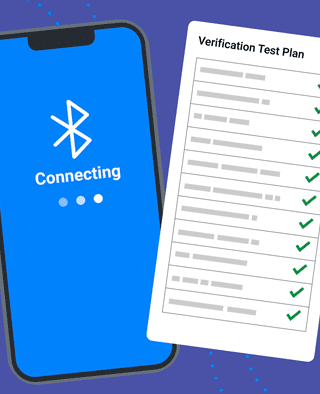
Article
Testing Strategies for Bluetooth Medical Devices

The following is the first of a three-blog series on the Validated State. This content builds on ideas first presented by Randy Horton, Bernhard Kappe and Pat Baird of Philips at the AAMI ISC 2021 conference. Orthogonal and industry partners will continue to present on this subject at conferences in 2022. For more details, visit our Events page.
Links to each blog:
–
MedTech meets at the crossroads of modern software development practices and strict regulatory oversight. As software developers, we want to take advantage of new innovations in technology. But as MedTech companies, we have to make those innovations work within our industry’s constraints. We have a responsibility to our patients, providers and other customers to ensure that the medical software we make is secure, accurate and validated.
The “validated state” is the proof that our medical software and quality systems are working as intended, and as affirmed by our regulatory filings and quality management systems standards. This concept has been the cornerstone of safe medical devices including Software as a Medical Device (SaMD), Digital Therapeutics (DTx) and connected medical device systems development. Without trust in the validation of our software, there’s no trust in the ability of MedTech to improve health outcomes.
Today’s software often lives in part or in whole on public clouds, hosted by tech giants like Amazon, Microsoft and Google. The benefits of cloud computing are numerous, such as scalability and stability, but for MedTech, these benefits come with significant areas of risk. If we choose the cloud, we are giving up some control of our software to the third-party cloud services provider. Those providers can make changes to the cloud as they see fit. They can give advance notice, but we can’t be absolutely certain that we’ll know ahead of time – or recognize a change after it is made. They could push updates or roll back changes that unintentionally risk the integrity and the validated state of our software.
As MedTech firms working at the intersection of modern software techniques and industry regulations, Orthogonal and its business partners recognize the huge potential for cloud computing to positively impact our software and thus patient outcomes. When Randy Horton and Bernhard Kappe were invited by Philips’ Pat Baird, in early 2020, to co-convene a panel of experts from our industry to discuss the cloud, they jumped at the chance.
The panel of industry experts formed a Task Group, sponsored by AAMI, the Association for the Advancement of Medical Instrumentation, to create AAMI CR510:2021, Appropriate use of public cloud computing for quality systems and medical devices, published in September of 2021. The Consensus Report Task Group concluded that the conditions of the cloud cannot support a real-time validated state. Rather, they determined that what is reasonable – and achievable – is an intermittently validated state.
The Consensus Report Task Group’s discussions on the cloud led them to a larger topic: The traditional MedTech regulatory, safety and quality concept of the validated state as we know it no longer reflects the realities of our modern, interconnected world of software. Reevaluating how we approach the validated state can have a positive impact on our industry.
As a new AAMI-sponsored Working Group takes the Consensus Report and refines it into a Technical Information Report, Orthogonal and our industry colleagues will continue to examine how the concept of the validated state can evolve to meet new opportunities and challenges in cloud computing, the wider world of interconnected software and beyond.
Learn more about the Consensus Report and the six key recommendations for a intermittently validated state in this article, and discover how these questions about the validated state apply to other modern computing technologies, such as APIs, bring-your-own-device smartphones and AI algorithms – which led us to coin the phrase “This Is Not Your Grandmother’s Validated State (TINY GVS)”– in this article.
Bernhard Kappe, CEO and Founder
Bernhard Kappe is a software development leader, technologist, and pioneer who consistently provides his clients with an unfair advantage by introducing them to important new trends and techniques at the leading edge of the adoption bell curve (e.g., Agile software development, Lean User Experience, Software Product Management, DevOps, Lean Startup and open-source software).
For the last eight years, as founder and CEO of Orthogonal, Kappe has exclusively focused on adapting these approaches to the medical device and HealthTech industry.
He has worked with clients including Novo Nordisk, Google, Tandem Diabetes, and Nanowear to connect medical devices to mobile apps and the cloud while shortening product development life cycles, improving delivery predictability, and creating engaging user experiences. By developing new diagnostic and treatment devices and business models, his clients have seen software-enabled market growth and improved patient outcomes and have contributed to bending the healthcare cost curve.
Bernhard can be reached via:
Email: [email protected]
LinkedIn: bernhardkappe
Twitter: @bernhardkappe
Phone: 312-626-4249 x 6002
Randy Horton, VP of Solutions & Partnerships
Randy Horton is VP of Solutions and Partnerships at Orthogonal, a software development consulting firm that gives medical device manufacturers an unfair advantage by helping them rapidly design and develop new Software as a Medical Device (SaMD) and connected medical device solutions. Randy Horton is passionate about helping established organizations break through to their “what’s next” by building new capabilities and launching new products and services that are both innovative and successful. Much of his career has been centered on working with healthcare and life sciences organizations to tackle the problems summarized in the Quadruple Aims: Improving the individual experience of care, improving the health of populations, reducing the per capita costs of care, and improving the work life of those who deliver care. Randy credits much of his passion for creative business thinking and being a connector of people and ideas to the four years that he spent at a Montessori pre-school. Noting that he still seems to live in the open classroom of his childhood, one of Randy’s executives once observed, “It’s not that Randy thinks out of the box. It’s that he doesn’t even have a box.”
Randy can be reached via:
Email: [email protected]
LinkedIn: randyhorton
Twitter: @randyhortonchi
Phone: 312-433-9437
Orthogonal is a software developer for Software as a Medical Device (SaMD), digital therapeutics (DTx) and connected medical devices.
We work with change agents who are responsible for digital transformation at medical device and diagnostics manufacturers. These leaders need to accelerate their pipeline of product innovation to modernize patient care and gain a competitive advantage.
Orthogonal applies deep experience in SaMD and the power of fast feedback loops to rapidly develop, successfully launch, and continuously improve connected, compliant products—and we collaborate with our clients to build their own rapid SaMD development engines.
Over the last 10 years, we’ve helped a wide variety of firms develop and bring their regulated/connected devices to market.
Almost twenty years ago, we began our consulting work to create great software products in a range of industries, including financial services, education, research, and healthcare. We spent nearly a decade working with leading-edge fast feedback loop techniques that have now become recognized best practices such as Agile software development (with XP, Scrum, and Kanban), Lean User Experience (Lean UX), and Lean Startup.
Nearly a decade ago, we got a glimpse of digital healthcare and the enormous potential of the cloud, IoT, and smartphones, and the potential impact of medical device software. Realizing that’s what we wanted to focus our energies on exclusively, we narrowed our focus to the development of SaMD, DTx and connected medical devices.
We’ve never looked back. Our team gets up every day excited to help move the needle on healthcare. For almost ten years, we’ve helped a wide variety of firms develop and bring their regulated/connected devices to market. We’re even more excited about the next ten years and what we will help accomplish during The Great Acceleration of Digital Health.
If you need help building your next connected device, or to learn more, send us a message or call us at (866) 870-9704.
Social Media
Website: https://orthogonal.io
Twitter: @orthogonal_io
This blog was the first of a three-blog series on the Validated State. Links to each blog:
Related Posts

Article
Testing Strategies for Bluetooth Medical Devices

Article
Don’t Patch That Medical Device! Quick, Patch It!

Article
Orthogonal-Contributed Article Wins Prestigious AAMI Prize

Article
TINY GVS: Reimagining the Validated State